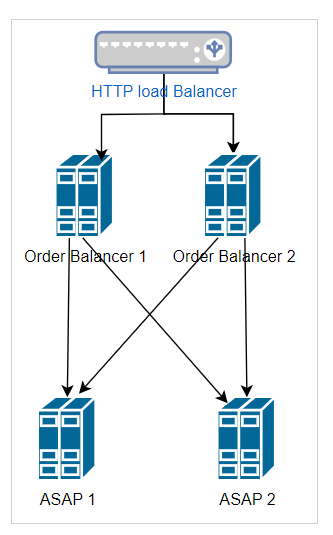3 ASAP System Requirements
This chapter describes the hardware, operating system, software, server, and database requirements for installing Oracle Communications ASAP.
Hardware Requirements
The number and configuration of the machines that you employ for your ASAP installation depends on the scale and the kind of deployment you have planned according to your networks.
ASAP Server Hardware Requirements
The ASAP hardware requirements described in this section are based on the number of ASDLs processed per second.
Table 3-1 provides recommended system hardware requirements for ASAP installed on an Oracle Linux platform.
Table 3-1 Hardware Requirements for Linux
| Software Components | Recommended System Linux 2 threads per core |
|---|---|
|
ASAP Server and WebLogic Server |
4 cores, 16 GB RAM |
|
Oracle Database |
4 cores, 32 GB RAM |
|
External Storage for Oracle Datafiles |
28 x 73 GB (RAID 1+0) |
Hardware Sizing Requirements
Table 3-2 describes the allocation of hardware sizing.
Table 3-2 Hardware Sizing Requirements
| Number of ASDLs | Recommended Size |
|---|---|
| Less than 40 ASDLs/second | 1 OCPU and 16 GB RAM |
| Up to 80 ASDLs/second | 2 OCPU and 32 GB RAM |
High Availability Sizing Requirements
Each ASAP instance in a high availability environment must be sized to handle the full load of orders when one ASAP system is unavailable.
Table 3-3 High Availability Sizing Recommendations
| ASAP Components | Recommended Size |
|---|---|
| Order Balancer virtual machine |
1 OCPU and 16 GB RAM |
| ASAP |
1 OCPU and 16GB RAM |
For full availability, you can have 2 Order Balancer systems with a HTTP load balancer in front of the Order Balancer for full high availability.
With this sizing recommendation, each ASAP instance can process 20 ASDLs/seconds in normal peak load, however it can handle the fulll load of 40 ASDLs/second when the other system is unavailable.
The sizing recommendation applies to both traditional and cloud native installations.
For more information on how to set up ASAP for high availability, see "Setting Up ASAP for High Availability" in ASAP System Administrator's Guide.
Figure 3-1 describes the high availability environment with the HTTP Load Balancer in front of the Order Balancer.
Figure 3-1 High Availability with HTTP Load Balancer
Software Requirements
For details about the software required to support the ASAP components for traditional deployment. See "ASAP Compatibility Matrix".
Information Requirements
During ASAP installation, you are required to enter configuration values, such as host names and port numbers. This section describes the information that you will be required to provide during the installation process. You define some of these configuration values when you install and configure the Oracle database, client, and WebLogic Server.
Oracle Database Information
Oracle database information is required for the configuration properties file. See "Configure ASAP Database" and "Configure ASAP Database Table space" in "Sample Configuration File" for the list of database parameters required for the ASAP installation.
Table 3-4 lists schema details that you are required to provide during installation.
Table 3-4 Schema user Information
| Configuration Parameter | Description |
|---|---|
|
Server Port Numbers |
ASAP configures ports based on the values set in the sampleASAPConfiguration.properties file. You can provide your own values during the configuration process. You can select ports for the following servers (where envID represents your ASAP environment ID):
|
For more information about creating tablespaces, see "About Creating and Configuring the Oracle Database."
WebLogic Server Connection Information
Table 3-5 lists WebLogic Server connection details that you are required to provide during installation. The values for the information types are read from the sample configuration (sampleASAPConfiguration.properties) file. See, Sample Configuration File for more details on the sample configuration file and its parameters.
Note:
You must enter the values for the information types in the sampleASAPConfiguration.properties file.Table 3-5 WebLogic Server Connection Information
| Information Type | Description |
|---|---|
|
Host Name of Oracle WebLogic Server |
You provide the host name for the WebLogic Server instance to define it uniquely for the specific purpose of installing, and working with, ASAP (for example, localhost). |
|
Port Number of Oracle WebLogic Server |
This is the port number assigned to this specific the WebLogic Server (for example 7001). |
|
User Name of Oracle WebLogic Server Administrator |
Your WebLogic Server user name. You define this name when you create an Oracle WebLogic Server domain. |
|
Password of Oracle WebLogic Server Administrator |
You define this password along with the user name when you create an Oracle WebLogic Server domain. |
